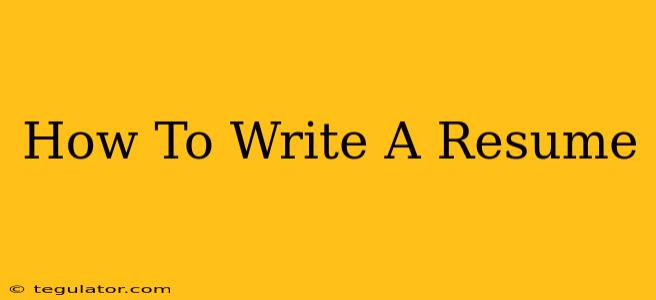Landing your dream job starts with a killer resume. This comprehensive guide will walk you through creating a resume that not only showcases your skills and experience but also grabs the attention of recruiters and hiring managers. We'll cover everything from choosing the right format to highlighting your accomplishments and optimizing it for Applicant Tracking Systems (ATS).
Understanding Resume Types: Choosing the Best Format for You
Before you dive into writing, it's crucial to select the resume format that best suits your experience and the job you're applying for. Three main formats exist:
1. Chronological Resume:
- Best for: Individuals with a consistent work history and significant experience in their field.
- Structure: Presents your work experience in reverse chronological order, starting with your most recent role.
- Pros: Easy to read and understand, clearly highlights career progression.
- Cons: Can be less effective for those with gaps in employment or frequent career changes.
2. Functional Resume:
- Best for: Individuals with limited work experience, career changes, or gaps in employment. Also beneficial for highlighting transferable skills.
- Structure: Emphasizes skills and accomplishments over chronological work history.
- Pros: Allows you to showcase your abilities even if your work history is less than ideal.
- Cons: Can raise red flags with some employers who may see it as an attempt to hide employment gaps.
3. Combination Resume:
- Best for: A blend of the two above, highlighting both skills and work experience. A versatile option for most job seekers.
- Structure: Combines elements of both chronological and functional formats. Typically starts with a skills summary followed by a chronological work history.
- Pros: Offers a balanced approach, showcasing both your skills and experience.
- Cons: Can be longer than other formats.
Crafting Your Resume Content: Key Sections and Tips
Now, let's focus on the content of your resume. Each section plays a vital role in making a strong impression.
1. Contact Information:
- Include: Full name, phone number, email address, and professional LinkedIn profile URL (optional). Keep it concise and professional. Avoid using unprofessional email addresses.
2. Summary/Objective (Optional):
- Summary: A brief overview of your key skills and accomplishments, ideal for experienced professionals. Tailor it to each job application.
- Objective: A statement of your career goals, better suited for entry-level candidates or career changers.
3. Skills:
- Highlight: Both hard skills (technical abilities) and soft skills (interpersonal skills). Use keywords from the job description whenever possible. Consider using bullet points for easy readability. Examples include communication, teamwork, problem-solving, leadership, data analysis, programming languages.
4. Experience:
- Use the STAR method: Describe your accomplishments using the STAR method (Situation, Task, Action, Result). Quantify your achievements whenever possible (e.g., "Increased sales by 15%"). Focus on results, not just responsibilities.
5. Education:
- Include: Your degrees, certifications, and relevant coursework. List your GPA if it's above 3.5.
6. Awards and Recognition (Optional):
- Include: Any relevant awards, honors, or recognitions that demonstrate your achievements.
Optimizing Your Resume for Applicant Tracking Systems (ATS)
Many companies use ATS to screen resumes. To ensure your resume gets past the ATS, follow these tips:
- Use keywords: Incorporate keywords from the job description throughout your resume.
- Simple formatting: Avoid using tables, columns, or unusual fonts. Stick to a clean and simple design.
- Save as a PDF: This preserves the formatting of your resume and prevents it from being altered by the ATS.
Polishing Your Resume: Proofreading and Feedback
Before submitting your resume, meticulously proofread it for any errors in grammar, spelling, or punctuation. Ask a friend, family member, or career counselor to review it for feedback. A fresh pair of eyes can catch mistakes you might have missed.
Key Takeaways:
- Tailor your resume: Customize your resume for each job application.
- Use strong action verbs: Start your bullet points with action verbs to make them more impactful.
- Keep it concise: Aim for a one-page resume unless you have extensive experience.
- Use a professional font: Choose a clear and easy-to-read font like Times New Roman, Arial, or Calibri.
By following these steps, you'll create a compelling resume that highlights your strengths and increases your chances of landing an interview. Remember, your resume is your first impression—make it count!

